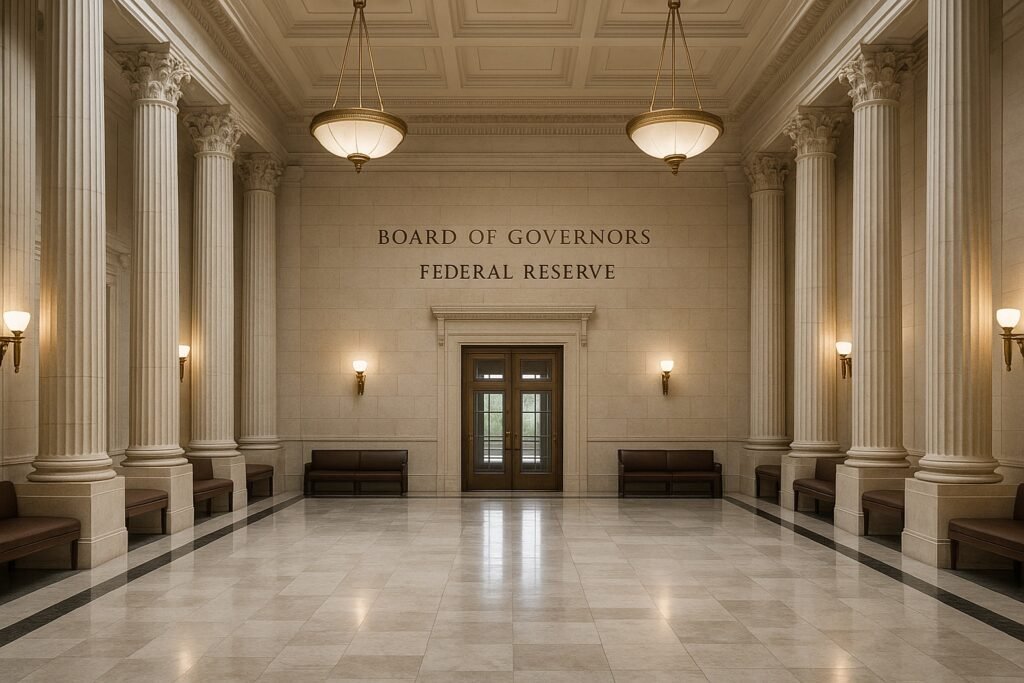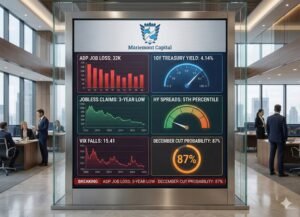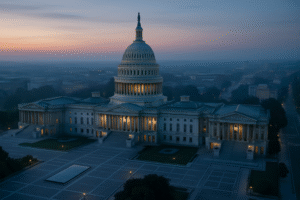Duration & Credit Pulse
Executive Summary
Bottom Line: Treasury markets moved lower late week as NY Fed President Williams' November 21 comments favoring additional near-term policy adjustment contrasted with earlier hawkish guidance from regional Fed presidents, with the 10-year yield declining 8 basis points to 4.07% as Fed December rate cut probability shifted from 32% to 75% within 48 hours. Market volatility reflected the absence of October inflation data following the 43-day government shutdown, leaving the Federal Reserve approaching its December 17-18 meeting without a key inflation reading while equity markets declined with VIX rising to 23.43.
Duration Dashboard
| Maturity | November 15, 2025 | November 23, 2025 | Weekly Δ | 5-Year Percentile |
|---|---|---|---|---|
| 2‑Year | 3.61% | 3.51% | -10 bp | 35th %ile (middle range) |
| 5‑Year | 3.73% | 3.62% | -11 bp | 41st %ile (middle range) |
| 10‑Year | 4.15% | 4.07% | -8 bp | 60th %ile (middle range) |
| 30‑Year | 4.75% | 4.71% | -4 bp | 84th %ile (elevated) |
Bull Flattening on Fed Dovish Pivot
Curve Analysis: Treasury yields exhibited bull flattening behavior as Fed December rate cut expectations surged following Williams' dovish comments, with front-end yields declining more sharply (2Y down 10 bps, 5Y down 11 bps) than the long end (30Y down just 4 bps). The 2s30s curve flattened modestly to approximately 120 basis points, with the 30-year yield remaining at the 84th percentile of its 5-year range despite the weekly decline. Market pricing showed classic risk-off characteristics with flight-to-quality flows concentrated in intermediate maturities where Fed policy transmission operates most directly.
Treasury yields declined across the curve as conflicting Federal Reserve signals created volatility that ultimately resolved in favor of expectations for continued policy easing. The 10-year yield fell 8 basis points to 4.07%, while the front end declined more substantially with 2-year and 5-year yields dropping 10-11 basis points to 3.51% and 3.62% respectively. The moves developed late Friday following NY Fed President John Williams' November 21 speech stating he sees "room for a further adjustment in the near term" to move policy closer to neutral—contrasting with cautious messaging from Atlanta Fed President Raphael Bostic and Boston Fed President Susan Collins earlier in the week who expressed preference for pausing rate cuts given persistent inflation concerns.
Credit Pulse
| Metric | November 15, 2025 | November 23, 2025 | Weekly Δ | 5-Year Percentile |
|---|---|---|---|---|
| IG OAS | 78 bp | 80 bp | +2 bp | 34th %ile (middle range) |
| HY OAS | 275 bp | 284 bp | +9 bp | 29th %ile (middle range) |
| VIX Index | 19.83 | 23.43 | +3.60 | 82nd %ile (elevated) |
Credit spreads widened modestly during the week despite the Treasury rally, with high yield expanding 9 basis points to 284 bps and investment grade adding 2 bps to 80 bps. The divergence between rallying Treasuries and widening credit spreads reflected equity market stress, as the Nasdaq Composite fell 3.0% for the week—its worst performance since April's tariff-induced selloff—amid concerns about AI infrastructure investment sustainability. VIX volatility surged 3.60 points to 23.43, reaching the 82nd percentile of its 5-year range, yet credit spreads remained in the bottom third of historical ranges at the 29th and 34th percentiles respectively, suggesting technical support from foreign buying and fund flows continues to dominate fundamental concerns.
Federal Reserve Policy Outlook: Notable Division Before December Meeting
The Federal Open Market Committee's October 28-29 meeting minutes, released November 19, revealed internal differences that complicate the December 17-18 policy decision. While the committee voted 10-2 to cut rates by 25 basis points to the 3.75-4.00% range, the minutes noted "participants expressed strongly differing views about what policy decision would most likely be appropriate at the December meeting." The minutes indicated that "many participants suggested that it would likely be appropriate to keep the target range unchanged for the rest of the year," showing considerable opposition to further near-term easing despite September's dovish pivot.
Regional presidents express caution on inflation persistence: Atlanta Fed President Raphael Bostic delivered cautious messaging on November 12, stating that "price stability remains the more pressing risk" and warning against "feeding the inflation beast." Bostic's business survey evidence indicated concern—CFOs expect to raise prices "just as much in 2026 as in 2025," with firms attributing 40% of total unit cost growth to tariffs in both years. Boston Fed President Susan Collins reinforced this view on November 12, stating it will "likely be appropriate to keep policy rates at the current level for some time" and expressing reluctance to provide "additional monetary support" absent clear labor market deterioration, noting the "limited information on inflation due to the government shutdown."
Williams' comments shift market expectations: NY Fed President John Williams' November 21 speech stating: "I still see room for a further adjustment in the near term to the target range for the federal funds rate to move the stance of policy closer to the range of neutral" provided a different perspective from the prior week's cautious messaging and led to adjustment in market expectations. Fed funds futures probability of a December cut increased from 32% Thursday to 75% Friday—a 43-percentage-point movement—demonstrating how the data gap amplifies individual Fed speaker influence. Vice Chair Philip Jefferson's November 17 speech offered middle ground, emphasizing that "the balance of risks in the economy as having shifted in recent months with increased downside risks to employment," supporting gradual approach toward neutral.
Economic Data Blackout Creates Policy Uncertainty
The 43-day government shutdown's most consequential market impact was the complete cancellation of October CPI data, originally scheduled for November 7 but subsequently scrapped when the Bureau of Labor Statistics determined retroactive survey collection was impossible. This leaves the Federal Reserve entering its December meeting without an October inflation data point, relying on September's 3.0% headline and core CPI readings. The November CPI release was rescheduled to December 18—after the December 17-18 FOMC meeting concludes—creating information asymmetry unusual in modern central banking. Producer Price Index reports for September and October similarly remained unavailable as of week's end.
The limited data releases that occurred provided mixed signals. Initial jobless claims for the week ending November 15 came in at 220,000 (down 8,000 from prior week), suggesting labor market stability, while continuing claims rose to 1.974 million (up 28,000), indicating gradual softening in reemployment dynamics. The Philadelphia Fed Manufacturing Index for November registered -1.7, improved from October's -12.8 but still in contraction territory and below consensus expectations. Consumer sentiment showed weakness—the University of Michigan final November reading of 51.0 represented the second-lowest measure in the survey's history, with the current economic conditions sub-index declining to 51.1, the lowest reading recorded.
S&P Global's flash November PMI data, released November 21, showed the Composite PMI rising to 54.8 from 54.6, indicating annualized GDP growth of approximately 2.5% for Q4 2025. However, Chief Business Economist Chris Williamson highlighted that input costs rose at one of the fastest rates in the past three years, with "tariffs cited as the predominant reason for cost increases." This inflation pressure metric conflicts with Fed rate cut expectations, explaining the internal committee division that October minutes revealed. The simultaneous presence of solid activity data and surging input costs creates the classic stagflation-lite environment that paralyzes monetary policy formulation.
Equity Market Volatility and Credit Market Resilience
Equity markets declined during the week, with the Nasdaq Composite falling 3.0%—its weakest weekly performance since April's tariff-related selloff—despite Nvidia reporting strong earnings Wednesday evening. Thursday saw notable intraday action with the Dow reversing 1,100 points from highs to lows, the largest such movement since April, while Nvidia stock closed down 3% after gaining as much as 5% intraday. The reassessment centered on whether hyperscaler AI infrastructure spending justifies current valuations given mounting debt issuance and uncertain monetization timelines. VIX volatility increased to peak at 26.42 on Thursday before retreating to 23.43 by Friday's close.
Credit markets demonstrated relative resilience despite equity weakness, with investment grade and high yield spreads widening modestly rather than experiencing the sharp repricing that volatility levels historically presage. The persistence of tight credit spreads—IG at 80 bps (34th percentile) and HY at 284 bps (29th percentile)—despite VIX at the 82nd percentile reflects powerful technical support from foreign demand and fund flows. Q3 2025 saw $193 billion inflow to long-term taxable bond funds, though this trend reversed with $17.77 billion in outflows during the week ending November 5, potentially signaling shifting dynamics.
The disconnect between elevated equity volatility and compressed credit spreads creates positioning challenges for institutional portfolios. Historical analysis suggests this configuration typically resolves through spread widening rather than volatility compression, as credit markets eventually price the economic uncertainty that equity volatility signals. The question facing fixed income managers is whether current technicals—foreign buying, elevated all-in yields, and solid corporate fundamentals—can sustain tight spreads through year-end despite macro uncertainty, or whether equity market weakness represents an early warning that credit markets have yet to fully incorporate.
Geopolitical Developments and Trade Policy
The Trump administration's November 10 trade deal with China addressed certain supply chain concerns, particularly around rare earth materials important for defense and technology applications. China committed to suspend export controls on gallium, germanium, antimony, and graphite announced in October, while agreeing to purchase 12 million metric tons of US soybeans during November-December 2025, scaling to 25 million metric tons annually from 2026-2028. In exchange, the US reduced fentanyl-related tariffs by 10 percentage points and maintained the 10% reciprocal tariff suspension through November 10, 2026.
The deal's fiscal implications merit attention—the administration reduced projected tariff revenue by $1 trillion, from $4 trillion to $3 trillion, affecting calculations around promised $2,000 "tariff dividend" checks to Americans. Current weighted average applied tariff rates reached 17.6%, with effective rates at 12.5%—the highest since 1941—yet 2025 tariff revenue likely totals only $225 billion according to Penn Wharton Budget Model. This revenue shortfall versus political commitments creates potential fiscal considerations that could influence Treasury supply and yields in 2026, though near-term market impact remained muted.
Frequently Asked Questions
What caused Fed December rate cut odds to increase on November 21, 2025?
NY Fed President John Williams' November 21 speech indicating openness to "further adjustment in the near term" provided a different perspective from earlier cautious messaging from regional Fed presidents, leading to a 43-percentage-point shift in December rate cut probability from 32% to 75% within 48 hours. The absence of October CPI data increased market sensitivity to individual Fed communications.
Why was October 2025 CPI data canceled and what does this mean for the Fed?
The 43-day government shutdown prevented Bureau of Labor Statistics from collecting October survey data, forcing complete cancellation rather than delayed release. This leaves the Federal Reserve entering its December 17-18 meeting without critical inflation data, with November CPI not available until December 18, after the meeting concludes.
How did Treasury yields perform during the week ending November 23, 2025?
Treasury yields declined 4-11 basis points across the curve in bull flattening fashion, with 2-year and 5-year yields falling 10-11 bps while 30-year yields declined just 4 bps. The 10-year benchmark fell 8 bps to 4.07%, driven by Fed rate cut repricing and equity market risk-off flows.
Why are credit spreads still tight despite VIX volatility reaching elevated levels?
Credit spreads remain compressed at the 29th-34th percentiles despite VIX reaching the 82nd percentile due to technical support from foreign demand and elevated all-in yields. However, this divergence has in prior periods resolved through spread widening as credit markets eventually incorporate economic uncertainty that equity volatility reflects.
Key Articles of the Week
-
Fed Minutes Reveal Deep Division on December Rate Cut PathCNBCNovember 19, 2025Read Article
-
Fed's Williams Says He Sees Room for Rate Cut in 'Near Term'BloombergNovember 21, 2025Read Article
-
Stock Market Today: Dow, S&P 500, Nasdaq End Turbulent Week With Sharp LossesYahoo FinanceNovember 21, 2025Read Article
-
Consumer Sentiment Lifts Slightly After Shutdown EndsUniversity of Michigan / Advisor PerspectivesNovember 21, 2025Read Article
-
Speech by Vice Chair Jefferson on the Economic Outlook and Monetary PolicyFederal Reserve BoardNovember 17, 2025Read Article
-
The Shutdown Put Jobs and Inflation Data on Hold: When It Could Be BackCNBCNovember 11, 2025Read Article
-
Bond Rally of 2025 Faces New Data Vacuum as Waiting Game BeginsBloombergNovember 23, 2025Read Article
-
Fact Sheet: President Donald J. Trump Strikes Deal on Economic and Trade Relations with ChinaThe White HouseNovember 10, 2025Read Article







